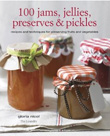HIGH HOPES FOR AN EGGY FUTURE
Saturday May 21st 2011, 2:03 pm

There is much excitement close to home, as me and next door are about to collaborate on our first chicken keeping venture. We have placed our order for 5 orpingtons; 2 lavenders, 2 buffs and a lavender cockerel, and will be taking delivery in a couple of weeks time. We can’t expect any eggs from them until around November time but most importantly – the names have been chosen. As I’ve never kept chickens before I’ve begun to swat up on them. I do know people who keep chickens, so suspect it isn’t too difficult and can already see which way this new interest is likely to go as even at this early stage we have started to discuss other breeds we might like and what colours of eggs they will hopefully produce.
In the meantime, I bought my first book on the subject; Hens in the Garden Eggs in the Kitchen by Charlotte Popescu. I’ve collected several other books of hers and can really recommend them. As well as chicken keeping, she writes about other subjects close to my heart, from wild fruits and apples to vegetable gardening and bee keeping. They are all small paperback books packed with useful information and recipes presented in a very simple and modest way.
In my new hen book she gives this really useful guidance about the freshness of eggs, particularly relevant to those people who know exactly when their eggs are laid. If you are buying shop bought you’ll just have to guess I’m afraid.
Your eggs need to be as fresh as possible if you want fried or poached eggs. For boiled eggs that you wish to peel, it is best to use eggs that are about a week old as the shell and skin are really difficult to peel off on fresh eggs. ….
If you are scrambling your eggs or making an omelette, eggs can be up to a week old. For baked dishes, eggs can be older than a week. If you want to separate the yolks and the whites to make meringues, eggs are best a few days old as the whites whisk up better if not too fresh.
Pickled eggs have never interested me until I came across a recipe for Pickled Huevos Haminados in another lucky find, The Mediterrannean Pantry by Aglaia Kremezi, published 1994. As soon as I read the recipe I knew I had to make it, though haven’t done so yet. I’m actually growing the red onions at the moment, which is, I suppose, beyond the call of duty. I have found the recipe online here if you fancy having a go and beating me too it. I’ll be tempted to serve a pickled egg with some asparagus spears pickled earlier.
This week I’ve been trying to make some room in the freezer before the berry season kicks off. I’m not a big fan of freezing as mine works on an ‘out of sight out of mind’ principle. I tend to forget what’s in there, all the while those ingredients are racking up additional running costs! (This year I’ll be canning fruit in jars as much as I possible.) I used a tub of blackberry puree, picked and prepared last August, and rustled up 4 pots of blackberry curd, which is a delicious way of using up eggs. A spoonful or two of fruit curd swirled through some Greek yoghurt is fabulous, or you can use it as the filling in a simple sponge cake or dollop on meringues (making use of even more eggs).
Oh yes, I’ve got eggs on the brain and this is only the beginning.
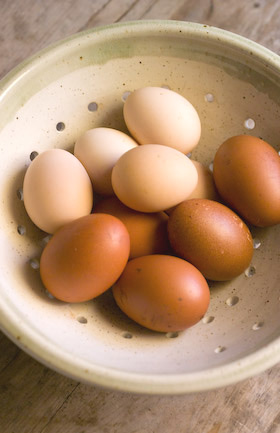
PICKLING ASPARAGUS
Monday May 09th 2011, 9:18 am
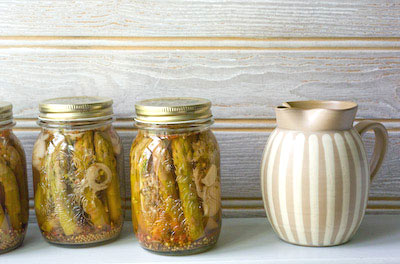
The asparagus season is in full swing. 14 of the 15 crowns planted in my newly prepared asparagus bed have started to appear, sending up very fine spears that then become frothy graceful ferns. They must be left alone for the time being to build up energy and form good sound crowns for the years ahead and I must be patient. I’m hoping the 15th crown is OK and wonder if I could have planted it upside down, and if I did, will it find its way right way up in time?
The other day I came across some bargain priced asparagus at the supermarket that had reached its sell by date, so was going cheap, half price in fact. Recognising a bargain when I see one, I bought up the lot so I could do some pickling. Since the Canjam last year, when other canners participating produced pickled asparagus, I’ve been wanting to experience this preserve first hand, but with this prized vegetable never exactly in abundant supply and always required for immediate scoffing, I couldn’t envisage when the opportunity to pickle some would arise. So watch what you wish for, here was my golden opportunity and I grabbed it with both hands.
I am now the proud owner of 5 x 500ml (1 pint) jars of pickled asparagus. I canned 3 to start with then had the idea to add the last of some wild garlic flowers, picked that day, so canned a couple more jars. I have no intention of sampling these pickles until the memory of the fresh English stuff is a distant memory, as this is not intended as a replacement for what is available in season right this minute. Some pickled spears, served with hard-boiled eggs, a handful of salad leaves and a wedge of homemade bread and butter will be a simple lunch to look forward too in 6 months time.

Fitting the spears into the jars is a wasteful business as they do need to be trimmed especially short to fit. I made asparagus soup with the stem cut-offs, so none went to waste, but shorter dumpier spears to start with makes the task less painful. There is no way I would have wanted to do this if I’d paid top wack for my ingredients.
PICKLING ASPARAGUS
I used 2 x 200g bundles of fresh asparagus spears to fill each 500ml (1 pint) jar, but it will depend how long the stems are and how much stem you’ll need to chop off so they fit into the jars. Allow a few more spears so they can be packed tightly into the jars and cut them so they fit snuggly and sit below the level of vinegar headspace when packed upright in the jars.
For each 500ml (1 pint) jar allow:
400g (1/2 lb) asparagus spears
120ml (1/2 cup) white wine vinegar
120ml (1/2 cup) water
1 tsp dill seed
1/4 tsp chilli flakes
1 tsp sea salt
1 small shallot, finely sliced
1/2 clove garlic, sliced
6 fresh wild garlic flowers (optional)
*Prepare the canning bath and keep your empty jars submerged in there until they are needed. Prepare lids in another pan of simmering water. Blanch the asparagus spears fleetingly in boiling water for 60 seconds, then drain them and cool immediately with cold water, so they don’t cook any further. Mix the vinegar and water in a pan and bring to a simmer.
Place the salt and spices in each jar, then pack the asparagus spears upright (or you can do them pointing down if you like!) in the jars, adding the shreds of shallot and garlic, and the wild garlic flowerheads in amongst them as you go. Pour in the vinegar/water to cover the asparagus, leaving the headroom necessary for your type of jar. De-bubble, to release any trapped air pockets surrounding the spears, using a chop stick or thin spatula. Wipe the jar rims clean and seal. Process for 10 minutes, then remove from the canner and leave until cold before testing the seals.
*Once canned like this your pickled asparagus will keep for a year or even longer. Pickling can be done successfully without hot water processing so long as the acidity of the vinegar / water used is high enough. Canning removes the guesswork!

MAKING EVERY HOT BUN A HAPPY BUN
Thursday April 21st 2011, 3:34 pm

Whilst once upon a time hot cross buns only turned up in the shops just before Easter, they can now be bought any old time. So one-a-penny, two-a-penny, hot cross buns are now ten-a-penny, having lost their seasonal specialness. I try each year to make my own, even if it is only just once and the buns turn out far superior to anything shop bought. Even using mixed spice from an old packet that has sat in the cupboard for just about forever, you make a better bun. But it is only when you actually grind and blend the spice mixture yourself, moments before baking, that you learn to appreciate what a difference really fresh spices make to the taste. With a comparative whiff of your own fresh and zestful mixture alongside an already opened packet of the shop-bought sort, it is blatantly obvious that one is doing a merry dance with the occasional pirouette whilst the other is wearing misshapen Ugg boots and dragging its feet in a slovenly fashion.

It really is worth taking a little extra time to grind your own spice blend. Use whole spices that are as fresh as they can be, but even with whole spices you’ve had a while, if you grind them yourself just before you need them, they’ll will have bags more flavour than ones already ground that have sat on the supermarket shelf for who knows how long.
I do have an old Moulinex grinder somewhere that I use just for grinding spices but haven’t a clue where I’ve put it, and am certainly not prepared to allow my coffee grinder to be tainted with spice. So on this occasion I pounded and ground the spices by hand with a pestle and mortar, which is a job I very quickly tire of, but I got the result I wanted in the end. I do think some help from an electrical appliance is the best option.
If you use lots of mixed spice, you’ll be able to adapt the blend to suit your own tastes and tweak the amounts accordingly. Can’t say I’m that tuned in to it yet, but here is the blend I made for my hot cross buns that I am very satisfied with. Perhaps next time I’ll try a bit more cardamon and add some fennel seeds as well. I didn’t have a cinnamon stick so did add my cinnamon and ginger ready ground.
MIXED SPICE
2tsp whole allspice
1 1/2 tsp whole cloves
2tsp freshly ground nutmeg (probably best to grate it separately first)
2tsp ground ginger
2tsp ground cinnamon or ground fresh from a cinnamon stick
1/2 tsp coriander whole seeds
4 blades of mace, broken up
seeds from 4 cardamon pods
Grind them all together to a fine powder. Keep in a well-sealed jar and label with the date.

I’m not partial to tasteless flour paste crosses on my buns though can appreciate the tidy result. I cut my crosses with a razor blade just before the risen buns went in the oven and this gives a much more haphazard, somewhat charming homemade look. You can of course make them non-denominational if you prefer and dispense with the cross altogether.
HOT CROSS BUNS
Makes 16 buns
500g strong white flour
7g packet of fast acting yeast
60g soft brown sugar
2 heaped tsp of mixed spice
1 tsp salt
60g butter, melted
1 egg, beaten
grated zest of 1 lemon (optional)
60g candied peel **
250ml milk, slightly warmed
120g currants
For the sticky glaze:
2Tbsp sugar
2Tbsp water
Place all of the ingredients except the currants in a food mixer with a dough hook and mix to a sticky dough for 5 minutes. You can of course use a bowl and combine by hand, but the mixture is quite soft and sticky. Add the currants and stir them through the dough. Cover the bowl with a tea towel and leave in a warm place for a couple of hours or a cold place for 4-6 hours until the dough has more than doubled in size.
Punch the dough down and empty the bowl’s contents onto a floured board then knead it for 2 minutes, incorporating more flour if needed to make a manageable, smooth dough. Form the dough into an even circle, cut into 4 equal pieces then cut each of these quarters into 4. Form each piece into a bun shape and place with some space between, on greased baking trays. Cover with tea towels and leave to rise and double in size. This will take as little as 30 minutes in a warm kitchen, or a couple of hours in a cool room.
Pre-heat the oven to 220C (425F, Mk7). Slash a cross in the top of each bun with a sharp knife or blade just before they go in the oven. Bake the buns for 15 minutes until lightly browned. Remove from oven and whilst hot brush generously with sugar glaze. To make this, dissolve the sugar in the water in a pan and bring to the boil.

** I didn’t have any candied citrus peel in the house so used some candied melon peel, which gives texture, but without the tang, so then added 2 Tbsp chunky cut marmalade to the mixture as well. (I’m telling you this, not to confuse you but to encourage you to make things up as you go along!)
A SEED PLANTING MASTERCLASS
Saturday April 16th 2011, 11:48 am
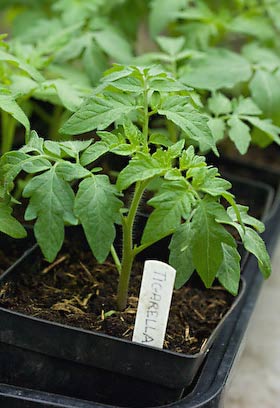
Well this week I managed to get my asparagus bed planted, which felt like no mean feat. The soil needed a lot of attention and I took great care to remove any perennial roots I could find as I sifted through it, as all the books tell you you must. When the asparagus crowns were safely in their straddling positions and covered with earth, instead of feeling a great sense of achievement I was positively down in the dumps; only 2 more years to wait for a crop. Whoopee, roll on 2013! By then I’ll be two years older but hey, I’ll be eating my own homegrown asparagus. I don’t seem to have quite the right attitude, do I?
Anyway, what next? Time to plant some seeds to fill in the gaps around my fruit bushes. I love buying the packets with inspiring pictures of my prospective crops on the front, but you really do have to get them in some compost as they don’t do that themselves. I decided to go visit my friend Shelley, who is a brilliant gardener and font of horticultural knowledge, for a masterclass in seed sowing. She will surely give me the inspirational uoomph I seem to be currently lacking to restore my gardening mojo.

Shelley is really into growing veg. She grows some for her local show and the competitive bug has well and truly taken hold. Her garden is set out in quite a formal way, with geometric shaped raised beds all working towards central focal points, in the style of a classic parterre with finials on every corner. There is a four sided regency arch with a chandelier hanging from the centre which will soon have sweet peas and climbing beans scrambling over it. The difference with Shelley’s planting style is that she fills the beds with vegetables and uses them in a decorative way. So instead of the beds being edged with box hedging, she uses broad beans with green stakes, or leeks growing for showing in terracotta tubes. Each year the planting changes as the crops rotate. She starts her potatoes off in small pots of compost then plants them as part of the pattern, planting and earthing up in one fell swoop. The soil looks amazing and she is the best person I know to consult when I want to know just what particular element a certain crop will need, beit more nitrogen or a little potash to get the best results.

First she showed me some seedlings that she hadn’t grown from seed. Both of us seem to have arrived at the point where we have realised it can be unproductive to want to grow absolutely everything. Sometimes being over ambitious can be a problem. Though we both share a love for unusual plant varieties we’ve concluded it’s better to grow a good classic, great tasting spud than some weird purple sort that only looks good in a photo. There is always room for experimentation but the best flavoured crops are now a priority. Shelley has some dill seedlings that were bought as one pot from Homebase which she then split to make six very healthy looking plants. That would suit me fine too. I need some dill for my pickling, so this would also work well for me. No need to always invest in a whole packet of seed.

Next she planted up a tray of her special Serbian pole beans. She’d been given this bean some years ago and saves more seed each year. This bean apparently has a very fine flavour, can be eaten fresh but stores well when dried. Perfect for my preserving garden. The compartments of a recycled seed tray were filled with Shelley’s specially mixed seed compost and a bean was pushed into each one, covered with a bit more compost, et voila, that was easy enough.
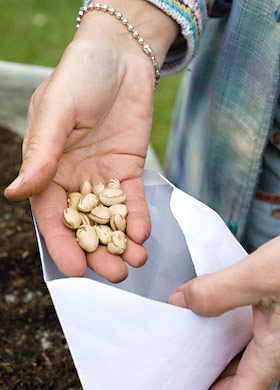
Shelley showed me her trick for broad beans, where she germinates the beans in a plastic bag partly filled with compost, just throwing her handful of beans inside, tying the bag and placing it by her Rayburn for a few days. It is also a good way of testing the viability of the seed if it has been hanging around for a while. This means that only germinated seeds get planted and avoids any gaps in the rows that you sometimes find when planting straight into the ground.
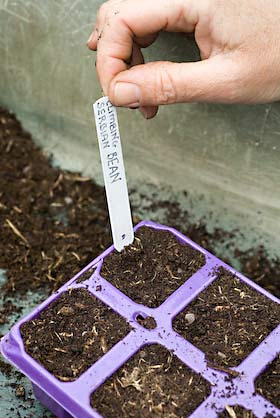
Seeds that traditionally would be sown straight in the ground and resent root disturbance can still be started off in pots, but for these a biodegradable pot works best. Beetroots and parsnips fit into this category. Shelley had some paper pots already made from newspaper for this job using a paper potter. The beetroot seeds contain several seeds in a cluster, so it is only necessary to put one seed per pot. By the time they are ready for planting out the newspaper will easily disintegrate and allow the roots to work their way out into the surrounding soil.
As the rows of seeds were sown each was labeled to avoid any confusion later on. All the seeds were lightly covered with compost except some romanesco brassica seeds that like to be planted on the soils surface. For these a light sprinkling of vemiculite neatly finished them off. All the seeds were given a sprinkling of water from the watering can then placed out of the way to germinate, in Shelley’s case on a shelf in a cold greenhouse.

So spurred on I set of back home, my tray of Serbian pole beans on the car seat beside me as well as a globe artichoke plant and a bunch of freshly picked lovage. I’m now feeling full of enthusiasm to get planting. As Shelley opened the gate for me to drive away, I thought I’d give something back in return and handed her a very healthy looking Jerusalem artichoke that just happened to be sitting in a bag in the car, recently collected from someone on Freecycle, who had offered them for free. They are the plumpest, healthiest artichokes I’ve ever seen in my life! Shelley was also suitably impressed with their quality and happily accepted my gift. That’s the great thing about gardeners, simple things can mean such a lot.
RHUBARB FLOWER SPOTTING
Friday April 08th 2011, 4:09 pm

Everybody’s rhubarb seems to be going to pot round here, going to seed and throwing up flower heads. Any rhubarb lover worth their salt will of course cut them off as soon as they appear so as not to exhaust the plant, like I showed in my last post and also wrote about here. Some people just don’t care and leave this vegetable to do its own thing. I must admit I love the sight of towering rhubarb flowers but love the taste of rhubarb more (this is starting to sound like a Harry Hill ‘F-I-G-H-T’). As I’ve got big preserving plans for my own homegrown rhubarb I am happy to leave the flower cultivation to others.
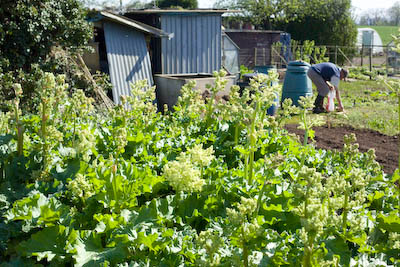
I have often noticed some rhubarb growing on an allotment in the village. It forms a particularly lush band going right across the width of a plot. Today I saw that it was all in flower so decided to stop to take some pictures. The old guy whose plot it is, thought I had stopped to request some rhubarb, as he doesn’t eat it! He said he sowed a packet of seeds three year ago, a variety of which he had no recollection, and this is what resulted. As far as he was concerned he’d be happy to get rid of the lot.
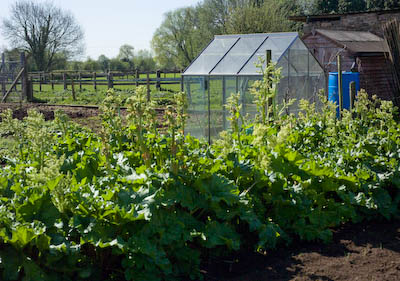
I have seen the flowers on sale in London as a cut flower. Can’t imagine them being popular round these parts but it’s a shame as the flowers, though strangely triffid-like, are rather grand and statuesque. I cut one off a plant in my garden and have it currently on my mantelpiece as a cut flower in a vase. They are big heavy blooms with hollow stems and like other cut flowers with hollow stems you need to hold them upside down and pour water into them till full, then bung up the end with a piece of cotton wool, before returning to upright and placing in a good heavy, topple-proof vase filled with water. The flower seems to be continuing to grow day by day, which is rather spooky.

THE PRESERVATIONIST’S PLOT
Monday March 28th 2011, 5:32 pm
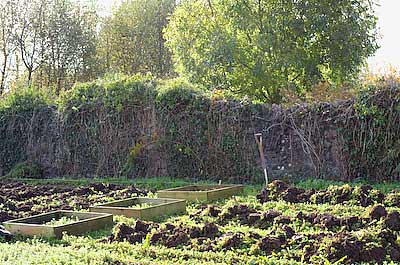
I am writing this post to cheer myself up. I’ve been busy knocking my allotment into shape for the growing season ahead and I think I’ve overdone it. Somehow no matter how much I dig and how many hours I spend trying to get through the jobs on the list, they just never get all ticked off. I’m the same with decorating the house. It is only once the job is completed that I feel the slightest glimmer of hope. So with still loads to do I decided to look back to see how far the plot has come since I first wrote about it here on my blog in October 2009. Looking at my original ‘before’ pics is helping me recharge so I can get out there some more.

I set out to plant a garden specifically with preserving in mind, so the bones of the plot are my fruit bushes; blackcurrants, gooseberries, white, pink and red currants, strawberries in abundance and rhubarb even more abundant. There’s a row of blueberries as well as raspberries and angelica, a mirabelle plum tree and an old English greengage. So the second season begins on an optimistic note even though I am momentarily gloom and doomy.

Thing is there is still a whole lot needs to be done. I’ve ordered asparagus crowns so their patch needs to be well and truly weeded and ready when they arrive in the next few weeks. The stone wall that bounds two sides of the plot has been cleared of ivy and I plan to plant along it, with some espaliered fruit trees, like apricot, fig and cherry along the top edge, where the most sun reaches. The ground along the wall is full of the roots of the ivy, nettles, ferns, ground elder and brambles, so the clearing out involved is quite exhausting and I’m impatient for it to be sorted so I can plant this season. That is the part of gardening that does my head in, learning to be patient and accepting the limitations that time allows.
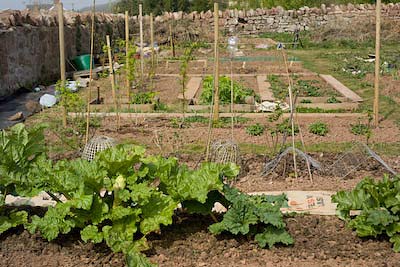
I’m quite pleased with the layout of the plot. The beds are all rectangles and squares made up as I went along, so the look is quite orderly but asymmetrical at the same time. I bought a job lot of old scaffolding planks last year intending to use them to edge the beds but I’m liking them laid down to form the paths between the beds with some hessian coffee sacks also covering some of the paths like fitted carpet. They’ve been pegged down with bent wire pins and will last for a year, hopefully longer, but in the meantime give the plot a nice tidy look and keep the weeds away. We have problems with rabbits and pheasants on the site, so you have to be on the defensive whenever anything is planted. Happily, there are fewer slugs and snails than I’ve ever experienced before.

With April upon us, it is now time to plant some seeds to fill in the gaps around the fruit. I’ve got some straightneck squashes to sow, that I loved in bread and butter pickle last year, dill for more pickling and borlotti beans for drying. My garlic for pickling scapes is growing well and hopefully the rabbits won’t take a shine to it.
The rhubarb is doing splendidly. I’ve harvested a few stalks already and will have more in the weeks ahead even though I need to go easy on the cropping as this is still early days. I think next year it will come into its own and again some patience is called for. Today I noticed there were a few flower heads starting to form, so it was necessary to cut them off so the plants don’t waste their energy needlessly.

I have high hopes for the strawberries planted last year. Fingers crossed they will do well this year and the preserving pan will be ready and waiting when they do (and some will be consumed fresh as well of course). I haven’t finished weeding the second strawberry patch yet and already have plenty of little plantlets potted up ready for a new home in my garden. Well, I’m feeling cheerier already. I’d best get out there and continue with the digging.
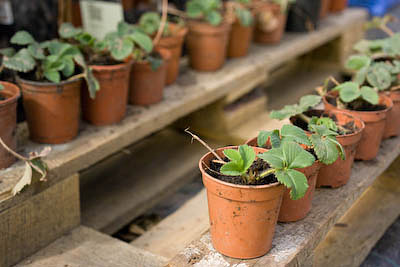
RHUBARB, BLUEBERRY & LIME JAM
Tuesday March 01st 2011, 1:39 pm

Last week I posted on the Guardian Organic Allotment blog and, though seemingly out of season berry-wise, wrote about planting blueberry bushes for jam. The recipe I included for rhubarb, blueberry and lime jam is a real favourite of mine, so to keep things in order and so’s regular readers don’t miss the recipe, I’m posting it here as well.
I only ever have small quantities of blueberries to play with but this recipe makes a little go a long way when used in combination with rhubarb and they add such a great colour to the jam. I buy up reduced priced punnets at the supermarket when I find them for a snip, up to their use by dates but still nice and fresh, then I freeze them to add to muffins, pancakes and jam. In summers to come, I hope to have a plentiful supply of my own berries, from the bushes I’ve just planted on my allotment. I’d much rather use ingredients that come from down the road rather than the other side of the planet. Well that’s the idea anyways.
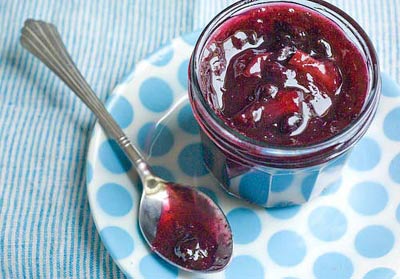
RHUBARB, BLUEBERRY AND LIME JAM
Makes 1.25kg (2 3/4lbs)
600g (1lb 6oz) rhubarb
300g (3/4 lb) blueberries
2 limes, the zest and juice
700g (1lb 8oz) sugar
Wash rhubarb, top and tail then chop into evenly sized pieces (I usually run a knife down the middle of the stalks then chop into roughly 1cm sized pieces). Place in a glass bowl and pour the sugar over the top. Cover with a plate or cling film and leave overnight, by which time the sugar will have soaked up the juice from the rhubarb.
Place the grated lime zest and blueberries in a pan, adding 3 Tblsp of lime juice. Heat gently and simmer for 15 minutes with the lid on, until the berries are cooked and surrounded by juice.
Prepare your canning bath and jars if planning to hot water process your jam, or put clean jars and lids in a cool oven for 20 minutes to heat and sterilise them.
Pour the rhubarb and sugar into a jam pan and stir over a low heat until the sugar is completely dissolved. Add the blueberries and lime, turn up the heat and cook at a rolling boil until setting point is reached (a small dollop of the syrup on a cold plate will readily form a skin when left to cool slightly). It took me 10 minutes to achieve this and I advise that you keep an eye on it and give the occasional stir whilst it cooks as the mixture is apt to burn if you’re not careful. Skim if necessary. Pour into hot sterilised jars, put a circle of waxed paper on the surface of each one and seal. Alternatively, pour into hot canning jars leaving the correct headroom for your type of jars, seal and process in a water bath for 10 minutes.
This jam has a nice soft set that suits me fine. If you prefer your jam to ‘cut’ rather than dollop substitute all or half of the sugar with preserving sugar that includes added pectin.
JAM JARS & MARMITE
Monday February 28th 2011, 2:27 pm

This is supposed to be a quick one, but in true geek style has become something more. Inspired by Kerstin Rodger aka MsMarmiteLover trailblazer and proprietor of the first underground supper club in the UK, whose blog post at The English can Cook about her love of jars and forthcoming supper club event this Friday Jar Food – Pickles, Potions and Preserves , got me thinking about …. jars. Seemed like a quick blog post to gather some of my favourite jars together, without it becoming some big deal would be a possibility. Trouble is, that when the differences in ridges on glass are something you admire, you get sort of, caught up. Anyway, here are just a few from my collection and I hope you enjoy them as much as I do.
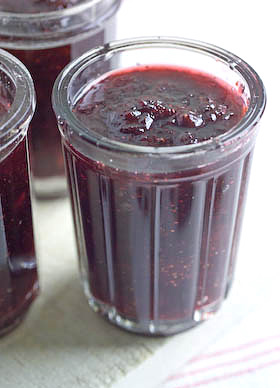
Vintage French jam jars are such classics and feature plenty of ridges and facets in all sorts of variations. A good heavy handful and chunky lipped edge are what you want. A few nibbles around the top are OK too. You can always use them as candle holders and vases if you don’t have any confiture to fill them with. I will be selling some of my vintage French jam jars at the Selvedge Spring Fair on the 2nd April in London. Follow link for more info.

When I wrote Fruits of The Earth my preserving book, (sorry currently out of print but will be available again in paperback in June) the publisher asked me to use some Ball jars, to suit the American market. They are virtually impossible to buy here in the UK but by one means or another, I’ve acquired a few along the way. These vintage ones in beautiful turquoise glass look great when used as vases.
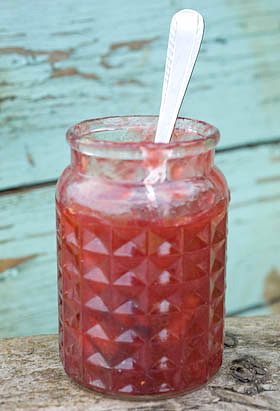
I always look out for interesting shaped jars and my vintage English Wye Valley Preserves jars (I’ve got 2 of them) are real favourites. They just wouldn’t make them like that these days. Finding them was sheer fluke, so sorry no tips on where to look. Just keep your eyes peeled.
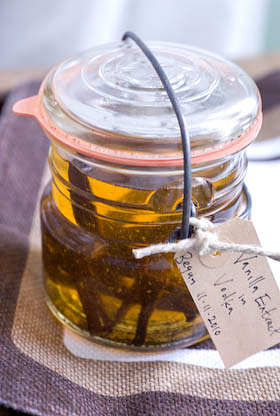
Another Ball canning jar, this time with wire bale clip top. These aren’t recommended any more for canning but people do still use them. Finding new rubber seals is the problem. See the brilliant Food in Jars for more info about this.
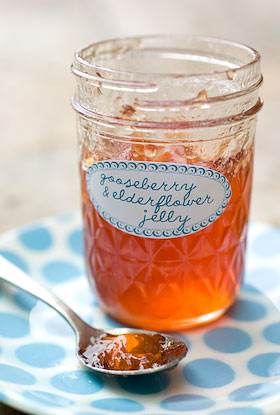
I love Ball quilted jelly jars and again you can’t buy them in the UK. My friend Chris brought me 2 back from the US a while ago and I use them repeatedly. They are so cute and worth looking out for if you are in the States.
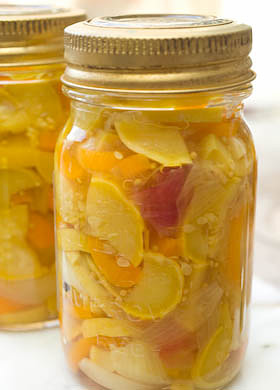
I’ve been given quite a few old Kilner jars by people. Often I’m given them because their owners think them now redundant but in fact you can still buy replacement seals for them. Peter Denyer at The Kilner Jar knows everything there is to know about Kilner jars, sells the seals and also reconditions the rusty tops. A real niche business. These Kilner Improved jars are great because they have a glass lid. For canning, there is something really satisfying about only natural materials, glass and natural rubber, being used here. Look out for old jars on your local Freecycle.
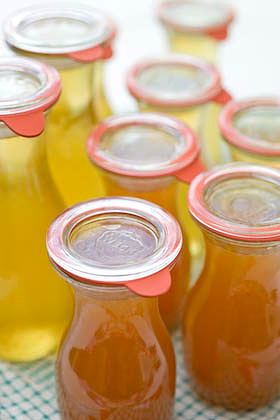
Weck jars and flasks have such simple lines and are great for the modern pantry. Again, just glass and rubber used here and they work so reliably. I’m a big fan of canning cordials and syrups and find the 1/4 and 1/2 litre size flasks most useful. Weck jars are really easy to open as you simply pull the rubber tongue to release the seal. Also seals are reusable.
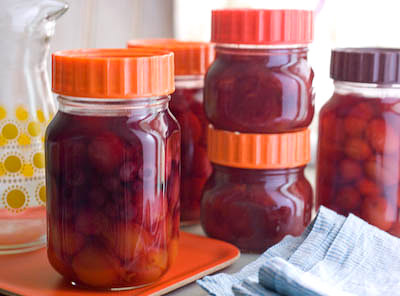
With great 70’s style, these vintage Ravenhead Kilner jars are another favourite that I use a lot. The screw bands were made in orange, red and brown plastic, and also white apparently, but I’ve never seen one of them. Again try The Kilner Jar for replacement seals. The last canned jar I tried to open was so well sealed that I had to email Peter Denyer for advice on how to prize off the lid. In true expert fashion, he told me to carefully slide a knife under the seal and gently lever. You have to be careful when doing this as chipped edges can totally ruin a canning jar and make it unusable.
Kerstin’s Jar Food supper club is one NOT to be missed. Also her book Supper Club – Recipes and Notes from The Underground Restaurant is available to pre order on Amazon and will be published at the end of March.
THE SELVEDGE SPRING FAIR
Friday February 18th 2011, 5:51 pm

Just to let you know that I will be exhibiting at The Selvedge Spring Fair on Saturday the 2nd April 2011 at St Augustine’s Church Hall, Langdon Park Road, London N6 5QG. 10am – 5pm Entrance £2.50 I will be selling textiles from The Laundry, vintage French jam jars as well as some of my homemade preserves. My talented and creative friend Deborah Schneebeli-Morrell will also be bringing along some of her amazing papercut designs and we are working on some really special labels for labelling preserves which wont be like any others you have come across before. I will tell you more nearer the time, but in the meantime, do make a note of the date in your diary. See the Selvedge website following the link to see who else will be there.
I PUT MANURE ON MY RHUBARB
Sunday February 13th 2011, 1:10 pm
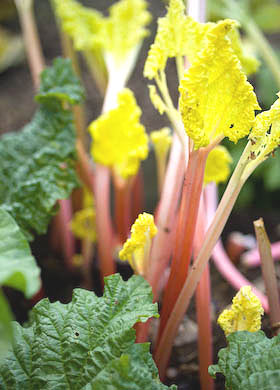
‘I prefer custard on mine’ …. I hear you reply!
Popping by the allotment, it is lovely to see the knobbly buds of rhubarb starting to push their way through. There is a rabbit nibbling problem at present, and like an arm wrestle between vegetable and animal, currently teetering in the rabbits favour, I’m confident that once the rhubarb gets a spurt on, the plants will win hands down and see off the fluffy predator.
The plot is fast beginning to resemble the national rhubarb collection, as I just can’t resist adding another variety when I come across one, conveniently forgetting that each crown will eventually take up a wacking great amount of space as it becomes established. Ho hum, who cares? All these varieties rarely mean much difference as regards taste, but for a rhubarb nerd it means you can admire the subtle variations of habit and leaf shape.
One variety I sought out especially, having grown it before on my London plot, is Livingstone, named after Red Ken. This variety is particularly useful as it has had the dormancy bred out of it, so gives a crop right through until the first frosts, unlike the others that you should stop picking in the summer months. You aren’t likely to find Livingstone for sale as it is produced under license so shouldn’t be propogated as the rights belong to the breeder, who I bought the original cultivar from, then years later tracked him down again and begged him to send me another crown (it is amazing how begging usually does the trick).
This is why there is no need to import rhubarb in the UK. We have the varieties available to harvest, virtually all year round. It always amazes me when I see rhubarb for sale in Tesco imported from New Zealand. My nearest independent greengrocers, usually sell Dutch rhubarb as the much lauded Yorkshire stuff is hard to source at the market or when found is too expensive for them. Now in my second year on the plot, I should be self sufficient in the stuff very soon, so such concerns will be for others to wrangle over.
It’s great that rhubarb is seeing a renaissance. I hadn’t eaten forced rhubarb until fairly recently, so I loved it before all the guff about not stewing it and that only the sweeter pink stems are worth having, bla-di-bla. The pinker it is the prettier it looks and you can juice it too, but for a diehard rhubarb fan brought up on stronger stuff, it is simply an hors d’oeuvres, leading the way to the main course.
Luckily, as one of my favourite flavours, when it comes to rhubarb, if you say ‘glut’ then I say ‘bring it on’. I may well become famous for my rhubarb ketchup, one day, but in the mean time here is a recipe for pink grapefuit, rhubarb and cardamom marmalade that I developed last year that usefully has a longer seasonal ‘window’ that the usual Seville orange sort and also just happens to taste great. The recipe doubles up fine if you want to make a bigger batch.
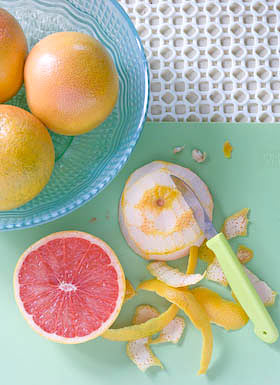
PINK GRAPEFRUIT, RHUBARB & CARDAMOM MARMALADE
Makes approx 1.3Kg (3 lbs)
0.5Kg (1.1 lb) rhubarb
1kg (2.2lbs) sugar
juice of 1 lemon
seeds from 10-13 cardamom pods, crushed
3 pink grapefruits, approx 750g (1.65 lb )
Rinse the rhubarb stems and chop into 1cm (1/2 in) evenly sized pieces. Place them in a bowl with the sugar and lemon juice. Tie the cardamom seeds in a piece of muslin and push them inbetween the rhubarb, then cover with baking paper or clingfilm and leave for a few hours or overnight, so the juices begin to soak into the sugar.
Wash the grapefruit and remove the peel with a sharp knife or potato peeler, leaving as much of the pith on the fruit as possible. Finely cut the peel into shreds. Squeeze the fruits and collect the juice and tie the remaining pulp, pith and pips together in a muslin bundle. Place the shreds, juice and bundle in a pan, add 1.4ltr (2 1/2pt) water and simmer for 1 1/2 – 2 hours until the peel is cooked through and tender. Remove the muslin bundle and, when cool enough to handle, squeeze the juice from it back into the pan, then discard. Pour the peel through a sieve and collect and measure the liquid, adding more water if necessary to make it up to 1ltr (1 3/4 pts).
Prepare the jars and canner if you plan to hot water process the marmalade, otherwise, make sure your jars and lids are clean and place them in a warm oven to heat and sterilise. Place the cooked shreds, cooking liquid and the contents of the rhubarb bowl in a preserving pan and bring slowly to the boil, stirring to make sure all the sugar is dissolved. Bring to a rolling boil and cook on a high heat until setting point is reached, that is when a small blob of the syrup on a cold plate quickly forms a skin when you run your finger across the surface. Remove the cardamom bundle.
Fill the jars, leaving the appropriate amount of headroom for canning, and seal. Hot water process for 10 minutes, then remove from the canner, leave till cold and test that the lids are sealed. Label and store. Alternatively, without canning, place waxed paper discs on the surface of the marmalade and seal. This marmalade should store safely without canning, but hot water processing will make doubly sure that your jam will keep and store without a hitch.





